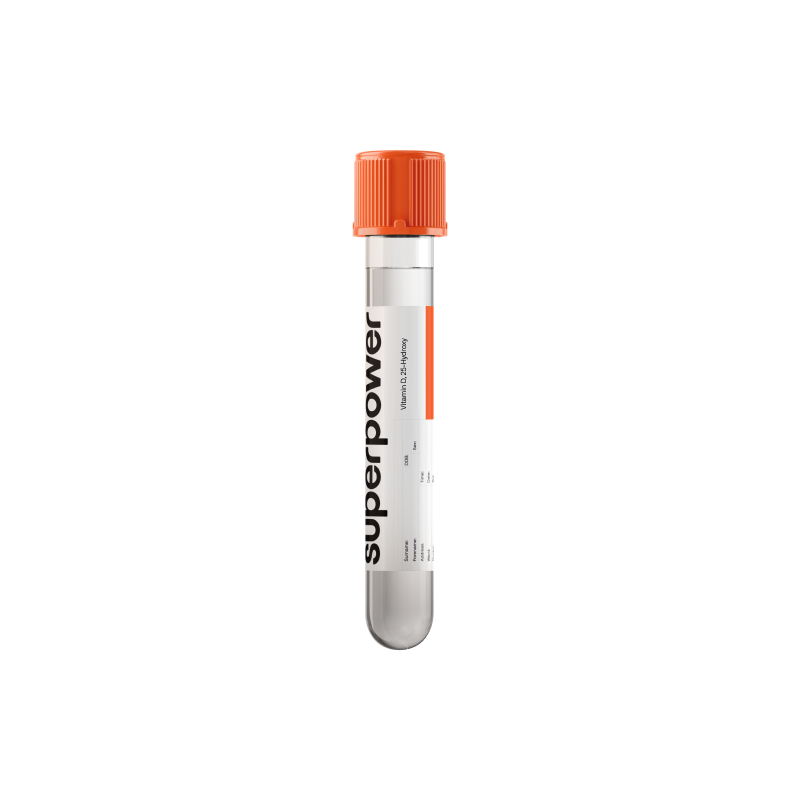Know your Vitamin D, 25-Hydroxy numbers to optimize bone strength, muscle function, immune resilience, and lifelong vitality.
Key Benefits
- Check your overall vitamin D status to support bones and whole-body health.
- Spot deficiency or excess that raises risks for fractures, falls, and osteomalacia.
- Clarify causes of fatigue, bone pain, or muscle weakness linked to deficiency.
- Guide safe supplement dosing and sunlight strategies tailored to your levels.
- Support fertility and pregnancy by correcting deficiency per obstetric and endocrine guidance.
- Track treatment response and seasonal trends to keep levels within target range.
- Support fracture prevention when treating deficiency, especially with calcium in osteoporosis care.
- Best interpreted with calcium, phosphorus, and PTH when bone or parathyroid issues suspected.
What is Vitamin D, 25-Hydroxy?
Vitamin D, 25-Hydroxy is the principal circulating form of vitamin D produced by the liver. Sunlight on skin creates vitamin D3 (cholecalciferol), and foods or supplements provide vitamin D2 or D3; the liver converts these into 25-hydroxyvitamin D (25[OH]D, calcidiol). In the bloodstream it travels mostly bound to a carrier protein (vitamin D–binding protein), serving as the body’s main reservoir of vitamin D.
Physiologically, 25-hydroxyvitamin D is the supply line that enables production of the active vitamin D hormone. The kidneys, and some other tissues, use it to make 1,25-dihydroxyvitamin D (calcitriol) as needed, which boosts calcium and phosphate absorption from the gut, supports bone remodeling, and helps regulate parathyroid activity and muscle and immune function. Because it is abundant and relatively long‑lived in blood, 25[OH]D reflects the total vitamin D coming from sun, diet, and supplements over time. In short, it tells how much vitamin D your body has available and fuels the hormonal actions that keep mineral balance and skeletal health on track.
Why is Vitamin D, 25-Hydroxy important?
Vitamin D, 25-hydroxy is the body’s main circulating “banked” form of vitamin D, produced in the liver from sun or dietary sources. It is the best single marker of vitamin D status and underpins calcium–phosphate balance, bone and muscle strength, and immune signaling, with ripple effects across the nervous, endocrine, and cardiovascular systems.
Most labs consider values below about 20 low, 20–29 borderline, and roughly 30–50 generally sufficient; some report upper reference limits extending toward 80–100. For most people, health outcomes tend to be best in the middle of the range rather than at the extremes.
When this marker is low, it reflects inadequate supply or higher physiologic needs. The parathyroid glands respond by raising parathyroid hormone, pulling calcium from bone to keep blood levels stable. Over time this drives osteomalacia in adults and rickets in children, with bone pain, fractures, muscle weakness, and more falls. People may notice fatigue or diffuse aches. In pregnancy, low levels are linked to impaired fetal skeletal mineralization. Postmenopausal women are particularly vulnerable to accelerated bone loss.
When it is high, it is most often from excessive intake. The result can be elevated blood calcium, leading to thirst, nausea, constipation, confusion, kidney stones, and reduced kidney function; in severe cases, soft-tissue calcification and heart rhythm problems. Infants and children are especially sensitive to these effects.
Big picture, 25-hydroxy vitamin D sits at the skin–liver–kidney axis and interacts tightly with calcium, phosphorus, and parathyroid hormone. Keeping it balanced supports skeletal integrity, muscle performance, immune resilience, and long-term fracture risk, while avoiding excess protects kidneys and the cardiovascular system.
What Insights Will I Get?
Vitamin D, 25-hydroxy [25(OH)D], is the main circulating storage form of vitamin D. It integrates sun exposure, intake, and liver conversion, and supplies the kidney to make the active hormone calcitriol. Adequate 25(OH)D supports calcium–phosphate balance, bone and tooth mineralization, muscle performance, vascular and insulin signaling, immune modulation, and aspects of reproduction and cognition.
Low values usually reflect limited skin synthesis, low intake or absorption, sequestration in adipose tissue, or impaired liver/kidney conversion. Physiology shifts to reduced intestinal calcium uptake, compensatory rise in parathyroid hormone, and bone resorption, leading to poor mineralization (osteomalacia; rickets in children) and proximal muscle weakness with falls. Older adults and people with darker skin are more affected; in pregnancy, fetal skeletal mineralization may be constrained.
Being in range suggests adequate substrate for calcitriol, stable calcium–phosphate homeostasis, normal parathyroid tone, efficient bone turnover and muscle function, and balanced innate and adaptive immune signaling. Many groups consider mid-range values sufficient; higher-than-mid values do not consistently add benefit.
High values usually reflect excessive supplementation or, less often, extrarenal activation in granulomatous disease or lymphoma. Physiology favors hypercalcemia and hypercalciuria, with thirst, nausea, weakness, arrhythmias, kidney stones, and soft‑tissue calcification. Infants and pregnant individuals are more susceptible to calcium-related effects.
Notes: Season, latitude, skin pigmentation, age, adiposity, and acute illness influence levels. Estrogens and pregnancy raise vitamin D–binding protein, altering total concentrations. Anticonvulsants, rifampin, and glucocorticoids accelerate catabolism. Chronic liver or kidney disease reduces conversion. Assay methods vary; LC‑MS/MS is most specific, and lab reference intervals differ.



.svg)



.png)
.png)
.png)
.png)








